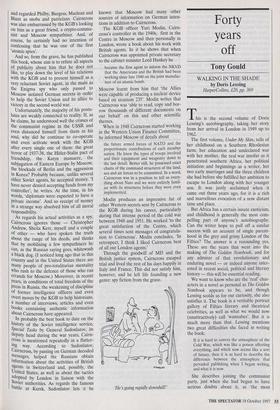Forty years off
Tony Gould
WALKING IN THE SHADE by Doris Lessing HarperCollins, £20, pp. 369 This is the second volume of Doris Lessing's autobiography, taking her story from her arrival in London in 1949 up to 1962.
The first volume, Under My Skin, tells of her childhood on a Southern Rhodesian farm, her education and undeclared war with her mother, the real war insofar as it penetrated southern Africa, her political initiation and beginnings as a writer, her two early marriages and the three children she had before she fulfilled her ambition to escape to London along with her younger son. It was justly acclaimed when it came out three years ago, for it is a rich and marvellous evocation of a now distant time and place.
But Africa has a certain innate exoticism, and childhood is generally the most com- pelling part of anyone's autobiography. Can the writer hope to pull off a similar success with an account of single parent- hood in the grey and grimy London of the Fifties? The answer is a resounding yes. These are the years that went into the making of The Golden Notebook, and for any admirer of that revolutionary and enduring novel — or indeed anyone inter- ested in recent social, political and literary history — this will be essential reading.
We want to know who are the 'real' char- acters in a novel as personal as The Golden Notebook appears to be, and though Lessing scolds us for our curiosity, she also satisfies it. The book is a veritable portrait gallery of Fifties literary and theatrical celebrities, as well as what we would now (unattractively) call `wannabes'. But it is much more than that. Lessing mentions two great difficulties she faced in writing the book:
If it is hard to convey the atmosphere of the Cold War, which was like a poison affecting everything, and which now seems like a sort of lunacy, then it is as hard to describe the difference between the atmosphere that pervaded publishing when I began writing, and what it is now.
She describes joining the communist party, just when she had begun to have serious doubts about it, as 'the most neurotic act of my life'. Perhaps so, but one wouldn't be without her account of a visit to the Soviet Union as a member of the British delegation to the Authors' World Peace Appeal. She is wickedly funny about her fellow travellers, Naomi Mitchison in particular, whose unconsciously patronising attitude to her Russian hosts is mercilessly exposed. Also present were Mitchison's cousin, the Russian-speaking Douglas Young, tall, thin and kilted; the novelist Richard Mason, determinedly philistine; the short-story writer A. E. Coppard, dedicated to seduction; and the Marxist critic Arnold Kettle who, along with Lessing herself, sought to protect the Russians from their outrageous guests.
This is comedy of a high order, as is a later description of her visit to Mitchison's country house on the Mull of Kintyre with her then partner (as we would now say), the American writer Clancy Sigal. But one does wonder at the savagery of it, especial- ly since Mitchison clearly regarded Lessing as a friend and ally.
The Russian visit is not all farce of course, and there is a moving moment at a collective farm when an old peasant in a white smock is determined to have his say, despite being surrounded by apparatchiks, and tells the visitors they mustn't believe what they're told, communism is really ter- rible . . . Lessing calls this the bravest thing she has ever seen. In general she is careful to distinguish how she felt at the time from what she knows with the benefit of hindsight; but her horror, not so much at her gullibility — for she doesn't see it as that — as at her wilful determination to believe what she knew, even at the time, to be untrue or at best partially true, comes over strongly. This is why she is so insistent on the distorting effect of the Cold War atmosphere.
If the collapse of communism has brought about an improvement in the international political climate, the triumph of capitalist forces in the publishing indus- try has done nothing but harm. Lessing writes nostalgically of old-style publishers who nurtured their writers and could say things like: 'Neither you nor I will make a penny out of this book, but it should be published.' Nowadays, when the majority of publishers are conglomerates run by accountants, such a remark would be unthinkable.
Walking in the Shade is structured around the flat or house moves Doris Lessing and her son Peter made every few years during this period. So it is also a vivid recreation of London's development from the grim, war-ravaged metropolis she came to in 1949 to something resembling the lively, bustling, cosmopolitan city that alternately delights and appals us now. 'The bliss of big cities', she writes at one point, 'is know- ing people who may not care to know each other.' Obviously, there are the celebrities she knew: the Royal Court crowd, John Osborne and his wives, Tony Richardson, Lindsay Anderson, Ken Tynan — 'like an elegant grey silky moth' — Edward Thompson and the New Left gang, various Americans, Kissinger even. But the book ends, appropriately, with an account of her acquisition of a house in a Somers Town neighbourhood threatened with demoli- tion. She describes its old-fashioned working-class community with a Dicken- sian relish which confirms — if confirma- tion were needed — her distinction as a novelist.
The Arts Council-administered British Literature Prize is awarded annually for a lifetime's literary achievement. Since its inception, Naipaul, Pinter and, most recently, Muriel Spark have received this prize. Doris Lessing, with her huge and impressively varied oeuvre, must surely be a serious contender now.



























































































 Previous page
Previous page